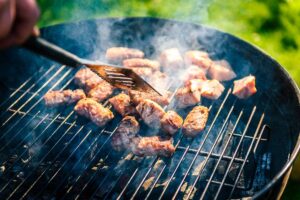
Many barbecue fans prefer charcoal grills. They give food a unique flavour, adding a smoky taste that gas grills often miss. However, as with any open-flame cooking, using charcoal grills can be risky if improperly handled.
Charcoal grilling is a fun way to cook outside. But safety must come first. Here are some steps to using a charcoal grill safely.
Choosing the Right Location for Your Grill
Before lighting your charcoal grills, ensure they’re in a safe spot to avoid accidents and fire hazards. Always use it outside in a well-ventilated area. Grilling indoors or in enclosed spaces can cause dangerous carbon monoxide levels. Put the grill on a flat surface to stop it from tipping over. Uneven ground can fall and spill hot coals.
Keep the grill at least 10 feet away from your house, deck railings, and other flammable things like trees, fences, or outdoor furniture. Ensure it’s placed where the wind won’t blow embers or smoke towards people or buildings.
Handling Charcoal and Lighter Fluid Safely
Handle charcoal and lighter fluid properly, as mishandling can lead to dangerous flare-ups or burns. Always store charcoal in a cool, dry place, away from children and pets. While lighter fluid can ignite your coals, too much is dangerous. Excessive fluid can create large and uncontrolled flames. Apply only a small amount and let it soak in the charcoal for a few minutes before lighting.
Chimney starters are an excellent alternative to lighter fluids. They offer a safer, environmentally friendly way to ignite coals without chemicals. Place newspaper at the bottom of the chimney, fill it with charcoal and light the paper. The heat will evenly ignite the coals.
Lighting the Charcoal Safely
Once your charcoal is prepared, lighting it safely is the next crucial step. Always have a fire extinguisher or a bucket of sand or water nearby before lighting the grill. Use long matches or a long-handled lighter to ignite the charcoal and keep a safe distance from the coals. After lighting, let the coals burn for 15 to 20 minutes. The coals are ready when they turn grayish-white with glowing red centers.
Don’t use gasoline or kerosene when lighting charcoal. These flammable liquids are highly volatile and not designed for grilling and using them can lead to uncontrolled fires or explosions.
Managing the Heat and Flames
Once your charcoal grill is fully lit, control the heat and flames for safe cooking. Charcoal grills usually come with adjustable vents that control airflow. Opening the vents increases oxygen flow, making the fire hotter. Closing them reduces oxygen and lowers temperature. Moderate airflow is needed for safe grilling, and the grill should not overheat.
Always use heat-resistant grilling gloves and long-handled tools to handle food or adjust coals to reduce burn risk. Remember that fat drippings from meat can cause sudden flare-ups. Keep a spray bottle filled with water nearby to spray the flames without flying ash onto your food gently. However, be cautious, as excessive water can extinguish your coals.
Never leave the grill unattended, especially when cooking fatty meats like burgers or steaks, which flare up. Keep a close eye on the grill to maintain control over the fire and prevent accidents.
Food Safety Tips
Food safety is just as important as fire safety when grilling. Store raw meat, poultry, and seafood in sealed containers separate from ready-to-eat foods to avoid cross-contamination. Using a meat thermometer is crucial to confirming your food is cooked correctly. Poultry should reach 165°F, beef burgers 160°F, and steaks should be cooked to at least 145°F.
It’s important to only place cooked food back on the same plate or tray that held the raw meat if it has been cleaned thoroughly with hot, soapy water. On hot days, keep perishable items like salads or raw meat in a cooler until you’re ready to cook.
Extinguishing the Charcoal
Once you’ve finished grilling, close the lid and all the air vents on the grill to cut off the oxygen supply. This will ensure that the coals will gradually extinguish. Once the coals are completely cool, carefully remove the ashes from the grill.
Place the ashes in a metal container or wrap them in aluminum foil before disposing them in a non-flammable garbage can. Don’t pour water over hot coals. It can cause dangerous steam and ash clouds and damage your grill by warping metal parts.
Storing and Maintaining Your Grill
Proper storage and maintenance of your charcoal grill will keep it safe and functional for future use. After the grill has cooled, remove leftover food particles and ashes to prevent rust. Next, cover it with a durable, weather-resistant cover to protect it from the elements. Store it away from flammable materials, especially if cooling coals are inside.






